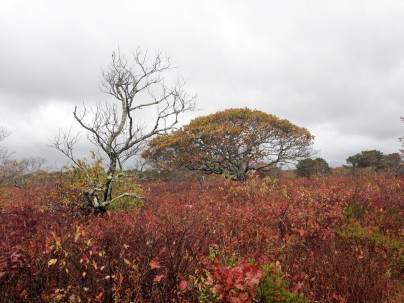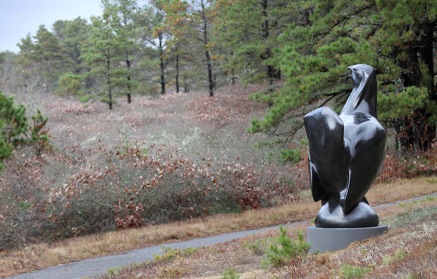The climate of Martha’s Vineyard is mild and moist. The mildness is reflected in its assignment to USDA Hardiness Zone 7a, which means that temperatures do not descend below 0 to 5 degrees F in the winter. This is the same zone as Philadelphia and Nashville. The Vineyard is also humid; it is an island surrounded by the relatively cold water of the continental shelf. As the island warms relative to the surrounding ocean, the air cannot help but be drawn in over the land, bathing it with moisture evaporated from the sea. It is a miniature version of the Pacific Northwest, where the prevailing westerlies rise up first the coastal range and then the higher Cascades, cooling as they rise and dropping their moisture as rain and a fine mist. The forests of the Oregon coast and the forest of Martha’s Vineyard are both hung with fruticose lichens.

The interior of the island is droughty though. It is mostly sand (or a sandy loam) and water that falls quickly sinks into the substrate, out of reach of most crops. It was not settled in until the advent of drilled wells in the 20th century. Much of it was forested, but some of it was heath, which is a plant community dominated by woody shrubs and characteristic of sandy, over-drained areas. So-called anthropogenic heaths are those created and maintained by burning, grazing, or both.
As it happens Thomas Mayhew, the Englishman who bought Martha’s Vineyard in 1642 and settled it, was born in Tisbury in Wiltshire in south of England. The New Forest, which is in fact a patchwork of forest, heathland, and pasture, is in Wiltshire (and Hampshire), so the landscape of the island he settled may not have been as different from his homeland as we might think.

To this day the New Forest is maintained in its patchwork condition by grazing. Blogger Stephen Bolwell describes the forest this way: “The look that is achieved with this approach to management isn’t exactly wild, but neither does it feel agricultural – it’s somewhere in between and usually happens in areas where the soil is too poor to support more intensive forms of agriculture.” Bolwell has been visiting the forest since the 1970s and has watched it decline due over-grazing by cattle and ponies. Plants like heather and bramble are now hard to find.
Once a grassland has replaced a heathland it is a precarious balance. Over-grazing can deplete even the grass leaving exposed sand, which elevates the temperature locally, causing a mesoclimate that makes the vegetation around the sand die and the desertification spreads. Heathlands are threatened in Massachusetts too. Here the threat is grazing, but also fire suppression and fragmentation by development.

Because the heath is a marginal environment — prone to drought and wide swings in temperature — many plant and animal species are found there and not elsewhere (or are much more rare elsewhere). Bearberry (Arctostaphylos uva-ursi) and black huckleberry (Gaylussacia baccata) are indicator species for sandplain heathlands. Sandplain heathlands and sandplain grasslands share about 70 percent of their dominant species: it is the proportion of the species and the resultant structure that separates the types. Sandplain heathlands look shrubby and appear taller and have fewer vascular plant species than do grasslands. Heathlands are structurally similar to maritime dune communities in that each has low shrub, herbaceous and grassy growth with patches of bare soil.
Martha’s Vineyard was the last hold-out of the heath hen, an eastern population of the greater prairie chicken. It was in part the failure to maintain the actual heathlands that led to its extinction in 1932. The Heath Hen Preserve was established in 1908 and a population that had declined to 70 at the end of the 19th century recovered to 2000 birds by the mid 1910s. But the management of the preserve included fire suppression. Not only did this along the open grassland to succeed to scrub, but when fires did occur, they were dangerous. A 1916 conflagration precipitated the final decline of the species.
